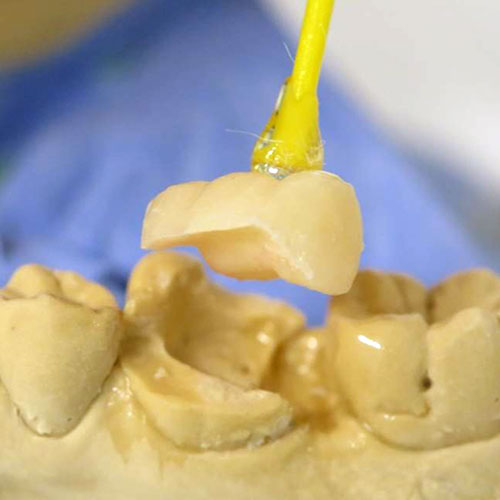DENTAL RESTORATION
Replacement of the missing tooth structure due to caries or fracture.
Onlays: many advantages and excellent aesthetics along with a great lifespan.

Onlays and inlays are used to restore teeth with missing dentin due to caries or fracture. They are placed on the posterior teeth (premolars or molars) and they can be either small (inlays) or bigger (onlays) according to the fracture. Onlays are basically fillings that are instead manufactured at the dental laboratory and then bonded on a perfect match onto the remaining tooth with special cements. They are usually preferred in medium sized tooth fractures that cannot be restored with a simple white filing and are not severely damaged in order to be restored with a crown. They can be either composite or porcelain onlays. Porcelain offers increased strength, longevity and aesthetic appearance, while composite onlays are a more affordable choice.
Onlays are preferred at the following cases:
- Replacement of big white fillings
- Tooth fractures
- Tooth after root-to-canal treatment
- Posterior teeth of the lower jaw that are visible at speech and smile
- Patients at a younger age that want to avoid drilling
- Patients that want to avoid a crown
- Natural restoration for an aesthetics appearance
Inlays and onlays have an amazing aesthetics result and lifespan with an average lifetime of 8-15 years, depending on their size and material. Once this time period has elapsed, we advise you to book an appointment in Smiles Dental Clinic for an examination and a possible replacement. Onlays are resistant to corrosion from acidic food and stain deposition. They don’t contain any metal, thus avoiding the unaesthetic grey color that is observed in the metal-ceramic restorations. On the other hand, they are bonded with the rest of the tooth providing a natural result. Onlays, in addition to crowns, are a conservative restoration method that respect the healthy dental tissues while drilling only the damaged tooth, if not at all. They protect the teeth from fractures as well as cold and hot stimuli, as they are not affected by temperature like black fillings.
The treatment requires 2 appointments and 6-7 days in total in order to be completed. It is required that habits that impose excessive pressure on teeth, like chewing ice or biting and holding objects are avoided after the attachment.


